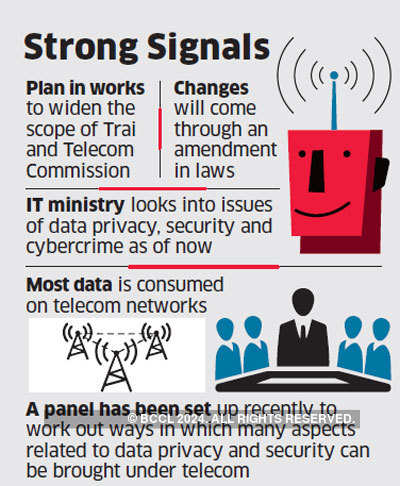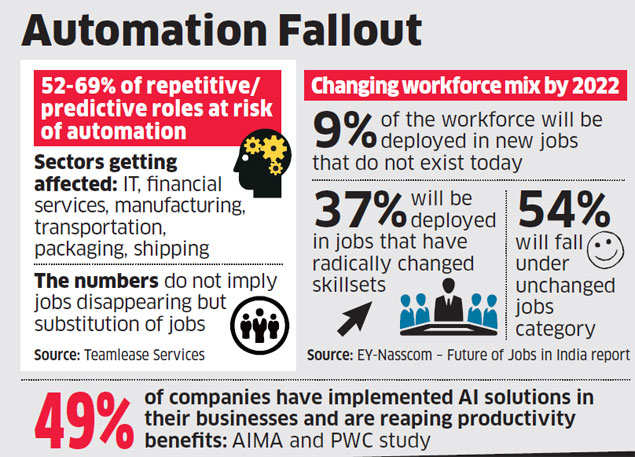MUMBAI: The remits of the telecom regulator and the Telecom Commission are in the process of being widened that may see them overseeing issues such as data privacy, security and cybercrime, which are currently being looked into by the IT ministry, people familiar with the matter said.
According to officials in the Department of Telecommunications and the Telecom Regulatory Authority of India (Trai), these changes, which will come through an amendment in laws, underline the fact that consumers access most of their data via mobile phones, and hence the telecom department will need to get involved.
“We have to realise that subjects such as data privacy and security all flow through the telecom network. In fact, 93% of all such data is consumed on telecom networks, for example ecommerce, etc,” said a senior government official, who did not want to be named.
“Aspects of data privacy etc should all come under one ambit, and that should be the Digital Commission and the Digital Communications Regulator,” the official said.
Any change in the regulatory ambit of one of the two institutions — the Telecom Regulatory Authority of India (TRAI) or the TC — needs to be complemented by a similar widening of the scope of the other. This, since all of the regulator’s recommendations need to be cleared by the Telecom Commission (TC).
Recently, the cabinet approved renaming the Telecom Commission to the Digital Communications Commission (DCC) while industry watchdog Trai became Digital Communications Regulatory Authority of India. “These cannot be just name changes. One needs to keep in mind that this will be the policy of the government, not of any ministry. Some changes need to be made in the remit of the Digital Commission and the Trai Act as well. It’s a work in progress,” said another senior official of the telecom ministry. Currently, the TC—an inter-ministerial body, which is the highest decision-making authority of the DoT—is headed by the telecom secretary.

The full-time members of the commission are member (finance), member (production), member (services) and member (technology). Part-time members of the TC are CEO of Niti Aayog, secretary (Department of Economic Affairs), secretary, ministry of electronics and information technology (MeitY) and secretary (Department of Industrial Policy & Promotion). The TC was set up via a government resolution in 1989. Trai, on the other hand, is governed by the Trai Act of 1997.
An inter-ministerial team was formed three months ago which is working on ways in which many aspects related to data privacy and data security are moved under telecom, said another DoT official. The official added that the team of experts includes officials of MeitY and the ministry of information and broadcasting (I&B).
“We have instructions from the top officials in the government to see how all privacy and datarelated issues can be seamlessly looked into under the governance of TC,” the official said.
A senior Trai official also confirmed that meetings are on and this would also lead to additional responsibility for the sector regulator, which currently regulates all matters related just to the sector, with consumer interests at the heart of its actions. “The jurisdiction of TC will increase keeping cybercrime in mind. It is still in the planning stage but talks are on to ensure that all the work that is done by DoT in dealing with data safety is put forward,” said another official aware of the developments.
The government plans to table the draft personal data protection bill submitted by Justice BN Srikrishna Committee in Parliament by December after holding consultations with different ministries, industry representatives and the public.
The bill, submitted to the IT ministry, recommends a layered consent architecture and bringing in key principles of personal data processing, whereby companies should collect only the required data from an individual, state the purpose of its use explicitly, and store it only for as long as it is required.
As per the draft bill, citizens and internet users will have the final say on how and for what purpose personal data can be used, and they will also have the right to withdraw consent.
The Trai, on its own, in mid-July had released its recommendations on the subject titled ‘Privacy, Security and Ownership of Data in the Telecom Sector’, which are applicable for apps, browsers, operating systems and handset makers.
-GoITWay
According to officials in the Department of Telecommunications and the Telecom Regulatory Authority of India (Trai), these changes, which will come through an amendment in laws, underline the fact that consumers access most of their data via mobile phones, and hence the telecom department will need to get involved.
“We have to realise that subjects such as data privacy and security all flow through the telecom network. In fact, 93% of all such data is consumed on telecom networks, for example ecommerce, etc,” said a senior government official, who did not want to be named.
“Aspects of data privacy etc should all come under one ambit, and that should be the Digital Commission and the Digital Communications Regulator,” the official said.
Any change in the regulatory ambit of one of the two institutions — the Telecom Regulatory Authority of India (TRAI) or the TC — needs to be complemented by a similar widening of the scope of the other. This, since all of the regulator’s recommendations need to be cleared by the Telecom Commission (TC).
Recently, the cabinet approved renaming the Telecom Commission to the Digital Communications Commission (DCC) while industry watchdog Trai became Digital Communications Regulatory Authority of India. “These cannot be just name changes. One needs to keep in mind that this will be the policy of the government, not of any ministry. Some changes need to be made in the remit of the Digital Commission and the Trai Act as well. It’s a work in progress,” said another senior official of the telecom ministry. Currently, the TC—an inter-ministerial body, which is the highest decision-making authority of the DoT—is headed by the telecom secretary.

The full-time members of the commission are member (finance), member (production), member (services) and member (technology). Part-time members of the TC are CEO of Niti Aayog, secretary (Department of Economic Affairs), secretary, ministry of electronics and information technology (MeitY) and secretary (Department of Industrial Policy & Promotion). The TC was set up via a government resolution in 1989. Trai, on the other hand, is governed by the Trai Act of 1997.
An inter-ministerial team was formed three months ago which is working on ways in which many aspects related to data privacy and data security are moved under telecom, said another DoT official. The official added that the team of experts includes officials of MeitY and the ministry of information and broadcasting (I&B).
“We have instructions from the top officials in the government to see how all privacy and datarelated issues can be seamlessly looked into under the governance of TC,” the official said.
A senior Trai official also confirmed that meetings are on and this would also lead to additional responsibility for the sector regulator, which currently regulates all matters related just to the sector, with consumer interests at the heart of its actions. “The jurisdiction of TC will increase keeping cybercrime in mind. It is still in the planning stage but talks are on to ensure that all the work that is done by DoT in dealing with data safety is put forward,” said another official aware of the developments.
The government plans to table the draft personal data protection bill submitted by Justice BN Srikrishna Committee in Parliament by December after holding consultations with different ministries, industry representatives and the public.
The bill, submitted to the IT ministry, recommends a layered consent architecture and bringing in key principles of personal data processing, whereby companies should collect only the required data from an individual, state the purpose of its use explicitly, and store it only for as long as it is required.
As per the draft bill, citizens and internet users will have the final say on how and for what purpose personal data can be used, and they will also have the right to withdraw consent.
The Trai, on its own, in mid-July had released its recommendations on the subject titled ‘Privacy, Security and Ownership of Data in the Telecom Sector’, which are applicable for apps, browsers, operating systems and handset makers.
-GoITWay


 Scientists, including one of Indian origin, have created an artificial inteligence (AI) tool to help developers design
Scientists, including one of Indian origin, have created an artificial inteligence (AI) tool to help developers design 